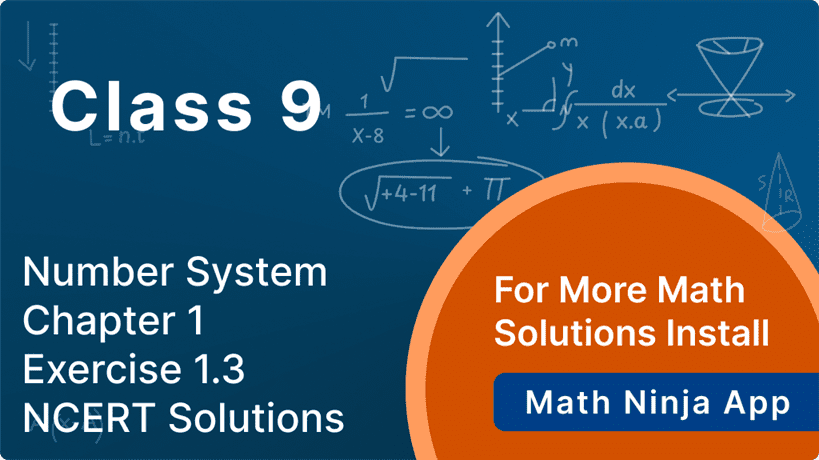Ncert solutions for class 9 maths || ncert exemplar class 9 maths solutions || ncert exemplar class 9 maths solutions chapter 1 || cbse class 9 maths ncert solution up board || number system questions with solutions pdf || ncert class 9 maths chapter 1 exercise 1.3 solutions || number system class 9 extra questions
Looking for NCERT Class 9 Maths Chapter 1 Exercise 1.3 solutions? You’re in the right place! This section provides clear, step-by-step solutions for all the questions in Exercise 1.3 from Chapter 1 – Number Systems. This exercise deals with the laws of exponents for real numbers, a fundamental concept that helps simplify and evaluate expressions involving powers. Understanding these laws is essential for building a solid foundation in algebra and advanced mathematics. Whether you’re revising for exams or clarifying your concepts, these well-structured solutions will guide you through each question with ease. Perfect for both quick revision and in-depth learning, this resource is designed to make exponent rules simple and easy to apply.

ncert solutions for class 9 maths || ncert exemplar class 9 maths solutions || ncert exemplar class 9 maths solutions chapter 1 || cbse class 9 maths ncert solution up board || number system questions with solutions pdf || ncert class 9 maths chapter 1 exercise 1.3 solutions || number system class 9 extra questions
Exercise 1.3
1.
For example: 0.2342516782943257 is neither repeating nor terminating expansion.
\( \frac{36}{100}=0.36 \)
(Since, decimal expansion has finite no. of figures. Hence, it is terminating).
For example: 0.2342516782943257 is neither repeating nor terminating expansion.
\( \frac{1}{11}=0.09090909 \ldots \)
\( =0 \overline{18} \) (Since decimal expansion repeats itself so it is a non-terminating recurring decimal expansion).
For example: 0.2342516782943257 is neither repeating nor terminating expansion.
\( 4 \frac{1}{8}=\frac{33}{8} \)
\( =4.125 \)
(Since, decimal expansion has finite no. of figures. Hence, it is terminating).
For example: 0.2342516782943257 is neither repeating nor terminating expansion.
\(\frac{3}{13} \) \(=0.230769230769\)
\( =0 . \overline{230769}\)
(Since decimal expansion repeats itself so it is a non-terminating recurring decimal expansion).
For example: 0.2342516782943257 is neither repeating nor terminating expansion.
\( \frac{2}{11}=0.1818181818 \ldots \)
\(=0 . \overline{18}\)
(Since decimal expansion repeats itself so it is a non-terminating recurring decimal expansion)
For example: 0.2342516782943257 is neither repeating nor terminating expansion.
\( \frac{329}{400}=0.8225 \)
(Since, decimal expansion has finite no. of figures. Hence, it is terminating.)
[Hint: Study the remainders while finding the value of \( \frac{1 }{ 7} \) carefully.]
\(\frac{2 }{ 7}=2 \times \frac{1 }{ 7}=2 \times 0.\overline{142857}=0.\overline{285714}\)
\(\frac{3 }{ 7}=3 \times \frac{1 }{ 7}=3 \times 0.\overline{142857}=0.\overline{428571}\)
\(\frac{4 }{ 7}=4 \times \frac{1 }{ 7}=4 \times 0.\overline{142857}=0.\overline{571428}\)
\(\frac{5 }{ 7}=5 \times \frac{1 }{ 7}=5 \times 0.\overline{142857}=0.\overline{714285}\)
\(\frac{6 }{ 7}=6 \times \frac{1 }{ 7}=6 \times 0.\overline{142857}=0.\overline{857142}\)
ncert solutions for class 9 maths || ncert exemplar class 9 maths solutions || ncert exemplar class 9 maths solutions chapter 1 || cbse class 9 maths ncert solution up board || number system questions with solutions pdf || ncert class 9 maths chapter 1 exercise 1.3 solutions || number system class 9 extra questions
3.
\( 0 . \overline{6} \)
Let \( \mathrm{x}=0.666666 \ldots \)
Multiplying both sides by 10
\(10 x=6.666=6+0.666\)
\(10 x=6+x\)
\(9 x=6\)
\(x=\frac{2}{3}\)
\( 0 . \overline{47} \)
Let \( \mathrm{x}=0.4777777 \)
Now multiplying both sides by \( 10,10 \mathrm{x}=4.77777777 \ldots \ldots\) eq(1) Now multiplying eq(1) by 100 we get \( 100 x=47.777777 \ldots\ldots\)
eq(2) Now eq(2) - eq(1) \( 100 x-10 x=47-490 x=43 x=\frac{43}{90} \)
\( 0 . \overline{001} \)
Let \( \mathrm{x}=0.001001 \ldots \) eq(1)
Multiplying both sides by 1000
\(1000 x=1.001001 \ldots=1+0.001001\ldots\text{eq}(2)\)
we can see that,
\(1000 x=1+x\)
\( 999 x=1 \)
\(x=\frac{1}{999}\)
multiply both sides by \( 1010 \mathrm{x}=9.9999 \) \( \ldots \ldots\)(2)
subtract (1) from (2).
\( 9 x=9 \)
As \( x=\frac{9 }{ 9} \)
or \( x=1 \)
Therefore, on converting \( 0.99999 \ldots \) in the \( \frac{\mathrm{p} }{ \mathrm{q}} \) form, we get the answer as 1.
The difference between 1 and 0.999999 is 0.000001 which is negligible. Hence, 0.999 is too much near to 1. Therefore, 1 as an answer can be justified
There are 16 digits in the repeating numbers of the decimal expansion of \( \frac{1 }{ 17} \).
Division check:

After 0.0588235294117647 digits will start repeating itself.
\(\frac{1}{2}=0.5 \text { denominator } \mathrm{q}=2^{1}\)
\(\frac{7}{8}=0.875, \text { denominator } \mathrm{q}=2^{3}\)
\(\frac{4}{5}=0.8, \text { denominator } \mathrm{q}=5^{1}\)
It can be observed that the terminating decimal can be obtained in a condition where prime factorization of the denominator of the given fractions has the power of 2 only or 5 only or both.
For example, when you divide 10 by 3, the answer you get keeps on dividing and no single value can be obtained but this number is recurring because \( \frac{10 }{ 3}=2.666666666 \) and in this value 6 is repeating or recurring. So we have to write a number which is non terminating and non-repeating. Write any number which does not end and does not repeat. ( \( 0.123123456345876 \ldots \ldots \) or \( 2.123231245627549 \ldots \) there can be infinite such numbers) Three numbers whose decimal expansions are non-terminating non-recurring are:
\(0.304004000400003 \ldots\)
\(0.80506000900005 \ldots\)
\(0.7205200820008200008200000 \ldots\)
OR
All irrational numbers are non-terminating and non-repeating.
Example: \( \sqrt{2}, \sqrt{3} \) and \( \sqrt{5} \).
Any number that is non-repeating and non terminating is an irrational number. To find irrational numbers first we find a decimal expansion of given fractions.
\(\frac{5}{7}=0. \overline{714285}\)
\(\frac{9}{11}=0. \overline{81}\)
Now, for irrational numbers, we write any non-terminating and non-repeating decimal number between given numbers.
Three different irrational numbers can be:
\( 0.74074007400074000074 \ldots \)
\( 0.75075007500075000075 \ldots \)
\( 0.78078007800078000078 \ldots \)
ncert solutions for class 9 maths || ncert exemplar class 9 maths solutions || ncert exemplar class 9 maths solutions chapter 1 || cbse class 9 maths ncert solution up board || number system questions with solutions pdf || ncert class 9 maths chapter 1 exercise 1.3 solutions || number system class 9 extra questions
9.
Irrational Number: A number which can not be expressed in the form \( \frac{\mathrm{p} }{ \mathrm{q}} \). The numbers that are non-repeating and non-terminating are called irrational.
\( \sqrt{23}=4.79583152331 \ldots \)
Since the decimal expansion is non-terminating and non-recurring hence, it is an irrational number
Irrational Number: A number which can not be expressed in the form \( \frac{\mathrm{p} }{ \mathrm{q}} \). The numbers that are non-repeating and non-terminating are called irrational.
\( \sqrt{225}=15=\frac{15 }{ 1} \)
It is a rational number as it can be represented in the form of \( \frac{p }{ q} \)
Irrational Number: A number which can not be expressed in the form \( \frac{\mathrm{p} }{ \mathrm{q}} \). The numbers that are non-repeating and non-terminating are called irrational.
0.3796
Since the decimal expansion is terminating number.
Therefore, it is a rational number
Irrational Number: A number which can not be expressed in the form \( \frac{\mathrm{p} }{ \mathrm{q}} \). The numbers that are non-repeating and non-terminating are called irrational.
\( 7.478478=7.4\overline{78} \)
Since the decimal expansion is a non-terminating recurring number.
Therefore, it is a rational number
Irrational Number: A number which can not be expressed in the form \( \frac{\mathrm{p} }{ \mathrm{q}} \). The numbers that are non-repeating and non-terminating are called irrational.
\( 1.101001000100001 \ldots \)
Since the number has decimal expansion as non-terminating and non-repeating.
Hence, it is an irrational number

